You can use a hamster to drive in a nail instead of a hammer, but neither you nor the hamster are going to be terribly happy about it. The point here is that things that seem very similar are not always as similar as you would think.
Not all splitters are created equal
Take as a case in point the humble DIRECTV splitter shown above. If you’ve recently cut the cord you probably have a few of these here and you’re thinking maybe you want to use them to distribute signal from your antenna to your TVs. It would be a good idea except, well, it isn’t.
DIRECTV splitters are actually some of the worst possible splitters to use for antennas. They’re very high-quality splitters to be sure, but they are designed for DIRECTV use and that’s what makes them poor splitters for antenna use. DIRECTV signals travel in the bands between 950 and 2150MHz, where antenna TV is more in the 56-700MHz range. First of all, splitters are designed to be most effective at certain frequencies, so there’s that working against you right now. The big problem, though, is that DIRECTV does something else with the frequencies between 475 and 625MHz: they’re used for networking.
The problem: coax networking
DIRECTV’s coax networking carries video to client boxes as well as other internet information to any HD receiver or DVR. It also carries 100% of the audio and video if you have a Genie system. As a result, all these boxes need to talk to each other, and DIRECTV receivers are designed to actually allow information from those frequencies to flow from port to port on a splitter.
We call this “port isolation” and in general most splitters have very high port isolation. Splitters with high port isolation will stop interference that’s on one line from going into other lines. It’s also easier to make a splitter with high port isolation. You actually have to work hard to build a splitter where the ports talk to each other.
Low port isolation is bad for antennas
This splitter works very well for satellite. However, when frequencies pass from port to port on a splitter used for antennas, you’ll see problems. There will be crosstalk and reception will suffer. That’s why a DIRECTV splitter is more or less the worst splitter possible for antenna use. Literally any other splitter is going to be better.
There’s good news at the end of this story though, and that’s if you are considering using your unused DIRECTV system to help you distribute antenna TV, all the cables are still going to be good. You just need to swap out the splitters and you’ll be all set. Even better news of course, is that we have a wide variety of really high-quality antenna splitters available at SolidSignal.com for very reasonable prices. Those DIRECTV splitters can go in a box. Eventually you can responsibly recycle them. Or give them away to hobbyist friends of yours so they can upgrade their DIRECTV systems. After all, not everyone’s a cord-cutter like you!




